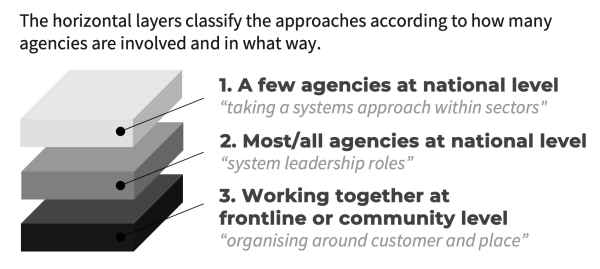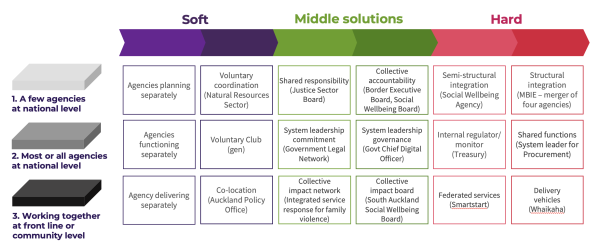Kete Rauemi Hoahoa mō ngā raru Guidance: System Design Toolkit for shared problems
This toolkit organises and presents many solutions to give public servants dealing with cross-agency problems an easy way to find the type of solution that might be most appropriate.
Ngā papa The layers

Te whānuitanga The spectrum
The range of system design approaches should be understood as a spectrum of increasing intensity in cross-agency working from ‘soft’ (voluntary) to ‘hard’ (structural reorganisation).
In the ‘middle’ are various approaches that involve greater commitment or mandated engagement without structural changes.
The spectrum can be seen as a loop where once structural integration takes place, agencies are back to operating separately.
Te Kete Rauemi The Toolkit
Putting the spectrum and the layers together gives us the following range of approaches — an example is provided for each.

The process
The first step for public servants using the toolkit is to establish what level the problem operates on.
Based on your understanding of the problem and context, the descriptions of when different solutions are used should guide you along the spectrum.
Within each solution, arrangements for agreeing on Goals/Outcomes, Governance Models, Ministerial Relationships, Incentives and Funding illustrate how an effective model may be structured.
The solutions
The solutions described in the toolkit are ‘ideal types’ but they are not rules or prescriptions. They, and the process, are meant to be flexible and iterative:
- different solutions may be appropriate at different stages in the initiative’s life cycle
- some problems may operate at multiple levels and solving them may involve combining approaches
- similarly, solutions from the same level may be combined to create a more layered and proportional response.
Key considerations
When deciding to pursue cross-agency working agencies need to be sure the benefits of doing so will outweigh the costs, and this should remain a key consideration when moving along the spectrum. Drivers of progression from soft to medium to hard might include:
- whether you are looking for responsibility or accountability. The medium solutions involve a shift from a sense of responsibility — which is fine in voluntary arrangements — to accountability to someone else
- the tension between collective and agency interests — the greater the tension the more likely formal arrangements and/or external governance will be required
- the current state of working together — the level of communication, trust and previous working between parties is a key factor in the success of collaborations
- the required durability of the cross-agency arrangement — ‘soft’ solutions tend to be less durable as they are more reliant on the interest of key individuals
- how many parties need to be involved in key decision-making arrangements — the effectiveness of collective decision rights and funding arrangements tend to decrease as the number of decision-makers increases.
Other considerations in implementing your approach should include:
- The type of agencies in the collaboration. The Public Service Act 2020 introduced interdepartmental executive boards and interdepartmental ventures because Public Service agencies (all legally part of the Crown) could not make legally enforceable agreements with each other. Other types of entity such as Crown entities or non-government organisations have no legal problem making binding agreements with each other and with departments
- Governance and delegations. If chief executives delegate, they must make sure that their delegates have the authority to take the decisions and do the work of the collaboration. Collaboration cannot thrive if some at the table lack authority to act
- How secretariat or backbone functions are established to support the spirit of the collaboration. If the biggest player provides all the support, it can make other participants less inclined to contribute. This was a key factor in the decision to host the Social Wellbeing Agency in a central agency, moving the functions from the Ministry for Social Development.
Detailed guidance on the Toolkit
System Design Toolkit — Detail
Further guidance and case studies: System Design Toolkit for shared problems
Find further information on Public Service system leaders: System leaders
Use the system architecture and design glossary
This glossary uses a mix of legal definition, conventional interpretation and additional description to help you understand system design and architecture terms.
System architecture and design
Appropriate structures, strong governance and clear accountability help the Public Service and wider public sector organisations to work together to deliver better outcomes for the public.